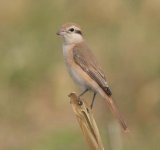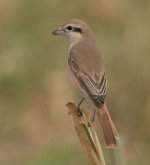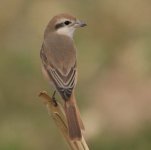Hi all,
A most intriguing bird in some respects: the outer tail feathers seem noticably short, and, in particular, the primary projection seems short for any Isabelline Shrike other than arenarius, which this bird is not, though, that said, there seem to be too many pro-Isabelline features for this to be any taxon of Brown: the tail colour, head and bill structure, apparent colouration of the upperparts and tail would all seem to exclude Brown, and the small whitish patch at the base of the primaries would also point towards some form of Isabelline Shrike, though Worfolk (in his paper in Dutch Birding) says that some Brown Shrikes can show such a patch.
I agree with the posters above that it seems to best fit phoenicuroides, and my own leanings towards a 2cy bird would be based on, say, the apparently evenly spaced growth bars on the visible tail feathers, not to mention the small primary patch, though I would not make any great claims for the age.







